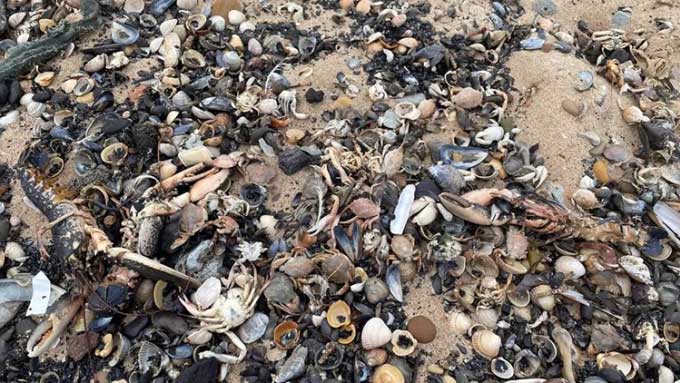Researchers in the UK blame chemical pollution for the mass deaths of crustaceans along the northeast coast.
Since late last year, a significant number of crustaceans, particularly crabs and lobsters, have washed up on the northeast coast of England, causing damage to the fishing industry. While the government announced that the cause was “algal blooms,” a natural phenomenon, new research from Newcastle, Durham, York, and Hull universities suggests that the dead animals are due to chemical pollution, BBC reported on October 1.

Mass deaths of crabs on the coast of England, suspected to be due to pyridine waste. (Photo: Sally Bunce)
The research team identified the presence of high levels of pyridine, which is used as a corrosion inhibitor in marine infrastructure. This toxic chemical affects crabs “even at low concentrations,” causing seizures and paralysis before death.
The source of pyridine has yet to be determined, but areas along the River Tees have a long history associated with heavy industry, particularly chemical plants. At least one plant processed large quantities of pyridine prior to 2019, the study noted.
Based on computer simulations of the currents and tides in the North Sea during and after the dredging of the River Tees, they found that pyridine could be quickly transported along the coastline, particularly around the Hartlepool and Redcar areas at the mouth of the River Tees, reaching as far as Whitby Bay if it is within the sediment layer.
The report stated that such pyridine discharge “could kill about 10% of the crab population in Whitby Bay, Robin Hood, and Peterlee, 30% in Runswick Bay, and over 50% in Redcar” after just 1 to 3 days of exposure.
The study also examined the phenomenon of algal blooms—rapid growth of algae in favorable conditions like “warm and calm seas” in autumn, but did not observe any abnormalities. Some algal bloom events even larger occurred in 2021 without causing mass deaths of organisms.
There is still much uncertainty, and further testing of water and sediment in the River Tees is needed, but the research findings indicate that pyridine and dredging activities may play a significant role in the observed mass die-off, scientists emphasized.


















































